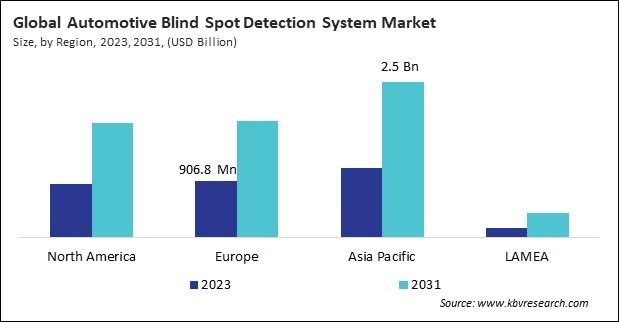According to a new report, published by KBV research, The Global Automotive Blind Spot Detection System Market size is expected to reach $6.6 billion by 2031, rising at a market growth of 10.3% CAGR during the forecast period.
As technology costs decrease and economies of scale improve, BSD systems are included in entry-level and mid-range vehicle models. This broader inclusion makes advanced safety features accessible to a wider range of consumers. Automotive manufacturers are integrating BSD systems into new vehicle platforms and models in their development process. This early adoption ensures that new vehicles are equipped with the latest safety technologies.

The ICE segment is registering a CAGR of 10 % during the forecast period. The ICE propulsion segment represents most of the automotive market, with many vehicles still using traditional combustion engines. The extensive presence of ICE vehicles creates a significant demand for safety features like BSD systems.
The Radar segment led the Global Automotive Blind Spot Detection System Market by Technology in 2023; thereby, achieving a market value of $3.2 Billion by 2031. Radar systems detect objects in a vehicle’s blind spots, especially in various driving conditions such as low light, fog, rain, or snow. Radar can penetrate through environmental obstructions and provide reliable detection, making it an ideal choice for BSD systems.
The Passenger Cars segment is growing at a CAGR of 10 % during the forecast period. Passenger cars account for a large share of vehicle ownership globally. With millions of passenger cars on the road, the demand for safety features like BSD systems is high to address the needs of a broad consumer base.
Full Report: https://www.kbvresearch.com/automotive-blind-spot-detection-system-market/
The Asia Pacific region dominated the Global Automotive Blind Spot Detection System Market by Region in 2023, and would continue to be a dominant market till 2031; thereby, achieving a market value of $2.5 Billion by 2031. The Europe region is anticipated to grow at a CAGR of 9.6% during (2024 - 2031). Additionally, The North America region would witness a CAGR of 10.1% during (2024 - 2031).
By Propulsion Type
By Technology
By Vehicle Type
 Unique Offerings
Unique Offerings